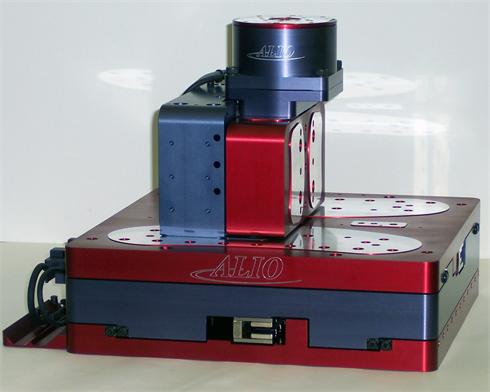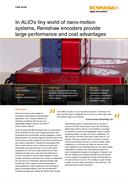Denna sida finns för närvarande inte på ditt språk. Du kan
översätta
den automatiskt
med Google Translate. Vi ansvarar inte för att tillhandahålla denna tjänst och
vi har inte kontrollerat översättningsresultaten.
Kontakta oss om du behöver ytterligare hjälp.
In ALIO's tiny world of nano-motion systems, Renishaw encoders provide large performance and cost advantages
Known for its nano-motion stages for biomedical, semiconductor and photovoltaic applications, ALIO Industries depends on Renishaw encoders for the accuracy and repeatability needed to drive its True Nano™ motion system solutions.
Wheat Ridge, CO – ALIO Industries' CEO Bill Hennessey lives in a world where small increments of motion carry large importance. In fact, he obsesses about nanometers and the inadequacy of mere planar precision. His company designs and builds some of the most precise automation stages for nano-level manufacturing and research applications, including microlithography, fiber optics, medical devices, micro-machine tools, geomatics, photovoltaics and semiconductors. In this world where a misalignment of one micron might as well be one meter, Renishaw encoders play a vital role in the performance of ALIO's True Nano™ and 6-D Nano Precision™ motion systems. According to Hennessey the minimal non-repeatable error and low cost of Renishaw steel and Invar® tape scale encoders give ALIO stages unmatched advantages in exotic applications, while maintaining a cost and footprint edge on competitive designs. ALIO also provides NIST-traceable metrology data utilizing the Renishaw ML10 laser interferometer system to verify performance.
The path to precision for ALIO motion systems starts with the thinking behind them (ALIO is Latin for "a new direction"). According to Hennessey, "accuracy and repeatability" relate to a planar positioning solution, but don't account for straightness, roll, pitch and yaw. "We think in 6-D terms, rather than 2-D", he explains. "'Accuracy' typically means a position on a plane, while we are aiming for accuracy to a point in space, where straightness, roll, pitch and yaw affect the outcome. Even many engineers do not understand that you can have excellent repeatability to a planar point while experiencing 'point-in-space' misalignment because of the degrees of freedom in an axis. Our designs and manufacturing objectives are focused on nano precision of straightness, flatness and elimination of roll, pitch and yaw in an axis. This is always our goal, though in reality it's not possible to be perfect in the real world only passionate about trying to achieve it".
From 2D to 6D Nano Precision
This kind of thinking has led to two patents for the company, with four more pending. To get the point across that it is a 6-D world, not 2-D, ALIO recently trademarked the term “6-D Nano Precision”, helping to distinguish its unique 6-D approach from the typical 2-D. "6-D Nano Precision™ comes into play when you're thinking about more than repeatability and accuracy in the plane", Hennessey added. "This becomes critically important when stitching features together, where you must look at things micron by micron with a camera or process. This is where 6-D comes into its own, because some of these products have contours, like a lens, so if your motion system is pitching up or down, you may not be able to achieve the needed measurement data".
Nano-resolution stages
ALIO's primary products are nano precision linear and rotary stages for standalone motion systems or stackable axes in various serial kinematic structures. Stages are available for end-user and OEM applications in atmospheric, clean room and vacuum environments. A typical 200 mm stage comes as standard with less than 1 micron of flatness and straightness with precision crossed roller bearings and less than ±30 nm repeatability when equipped with the TONiC encoder. True Nano air bearing systems with TONiC encoders offer less than ±25 nm repeatability with high stiffness and speeds from 1 micron/sec to over 1 m/sec to suit the application. Applications (see sidebar) include nano metrology, FPD, ink jet deposition, solar scribe, laser machining and others.
TONiC optical encoders help to achieve True Nano
ALIO has used various Renishaw encoder models from its start in 2001. "The encoder is a very important component in achieving True Nano and Renishaw's repeatability and accuracy from basic tape scales and Invar scales are unmatched", Hennessey adds. The TONiC™ optical encoder is currently a mainstay with ALIO. TONiC optical encoders provide the same accuracy as fragile fine-pitch encoders, but in a rugged, simple-to-install package. The compact readhead (35 mm x 13.5 mm x 10 mm L-W-H) allows great design/application flexibility and easy installation on micro-manufacturing systems. TONiC is available in both linear and rotary versions, offering speeds to a maximum of 10 m/s (3.24 m/s @ 0.1 µm resolution), fine resolution to 1 nm and operating temperatures up to 70°C.
TONiC delivers ‘fine pitch calibre' performance by combining innovative optics of very high signal-to-noise ratio, with dynamic signal processing to ensure ultra-low sub divisional error (SDE) and jitter.
Two integral readhead LEDs give quick and easy set-up and diagnostics. TONiC reads a variety of linear and rotary scale types including a new version of Renishaw's industry standard gold, stainless steel and Invar scales, featuring the auto-phase IN-TRAC™ optical reference mark. Integral dual limits are also available enabling users to select end-of-travel position.
Although ALIO stages can be interfaced to existing customer controllers, Hennessey says the highest performance is achieved with motion controllers that optimize the capability of the motion system in processing encoder feedback very quickly. ALIO primarily uses linear servo motors, torque motors and voice coils plus some ceramic servo motors in their products; the decision is application dependent.
The encoder is a very important component in achieving True Nano and Renishaw's repeatability and accuracy from basic tape scales and Invar scales are unmatched.
ALIO Industries (USA)
Parallel geomatics, Nano Z and planar air bearing systems technology
ALIO currently has two patents for parallel kinematic systems know as Hexapods which have forward and inverse kinematics to assure path and velocity nano precision to a 6-D point in space as well as two more patents pending for its Nano Z™ and planar air bearing systems. Designed with a large open center, the standard Nano Z virtually eliminates pitch, yaw and roll over the 24 mm travel range, and uses Renishaw encoders with the Invar scale to achieve better than 100 nm of accuracy when configured for "optional extreme precision". "Renishaw told us their top spec on repeatability and accuracy, so we're pushing up against this limit with better-than-expected performance", said Hennessey.
Sidebar: ALIO sets the stage for unique maskless lithography applications
Intelligent Micro Patterning (IMP), St. Petersberg, Florida, uses an ALIO 4-axis solution in its SF-100 line of maskless lithography systems to pattern mesoscale features on conventional flat surfaces, as well as provide the unique ability to produce features on non-flat and curved substrates. IMP was founded as a spin-off of Smart Filter Technology work done by David Fries at the University of South Florida. Prior to Fries' development of Smart Filter Technology, there were no commercially-available processing systems for patterning non-silicon, non-flat materials. Fries joined Dr. Jay Sasserath in 2001 to form IMP and put the benefits of Smart Filter Technology, and its five US patents, to work for various applications in the munitions, medical and research fields, among others. One of the unique medical applications for the system involves the placement of pharmaceutical materials on a stent.
"Maskless lithography on curved substrates is unique to us", said Sasserath, CEO of IMP. "The Smart Filter Technology, with its arc type light source, also provides cost and throughput advantages". According to Sasserath, two-thirds of IMP customers are involved with university research programs, with the remaining third coming from R&D companies using IMP's maskless lithography systems for applications in biotech, micro fluidics and MEMS. The IMP maskless lithography systems allow researchers to try out many different designs quickly and cost-effectively. "Our niche is on the research and development side, not the production side", added Sasserath. "Most important in the R&D world is the ability to turn quick iterations of different designs, and the ability to produce multiple designs on one wafer. This allows for cost-effective testing and confirmation of design configurations through empirical evidence". Previous methods using photomasks may take three to four design attempts, at a cost of $1,000 each, and the turnaround time was days Vs hours. "With our systems, users can design in the morning and start fabrication in the afternoon", added Sasserath.
Using ALIO stages has also provided financial advantages for IMP. "The stages we purchase from ALIO have better performance specifications than the stages we previously used, and they are priced significantly lower”, said Sasserath. "The stage is the most expensive subassembly in our system, as it is the key to our system's performance. The ability to move very precisely, at a good price point, is critical".
Smart Filter Technology uses proprietary, micro-optical techniques to project master images on a range of diverse substrates – including quartz, ceramics, metals and plastics – without the need for a photomask. IMP's line of SF-100 systems patterns individual images across the substrate, then stitches them together to make large dies or multiple copies of the same die on the same substrate. The role of the stage is critical to the stitching, as it controls the alignment of the exposures. "The ALIO stages have provided us with the capability to stitch together one micron sized features over large areas, often greater than 100 mm x 100 mm", said Sasserath. "The stitches are so accurate they are not observable under 400X magnification, and the reliability has been fabulous. Each stage works out of the box, and we've have no field failures reported to date”.


